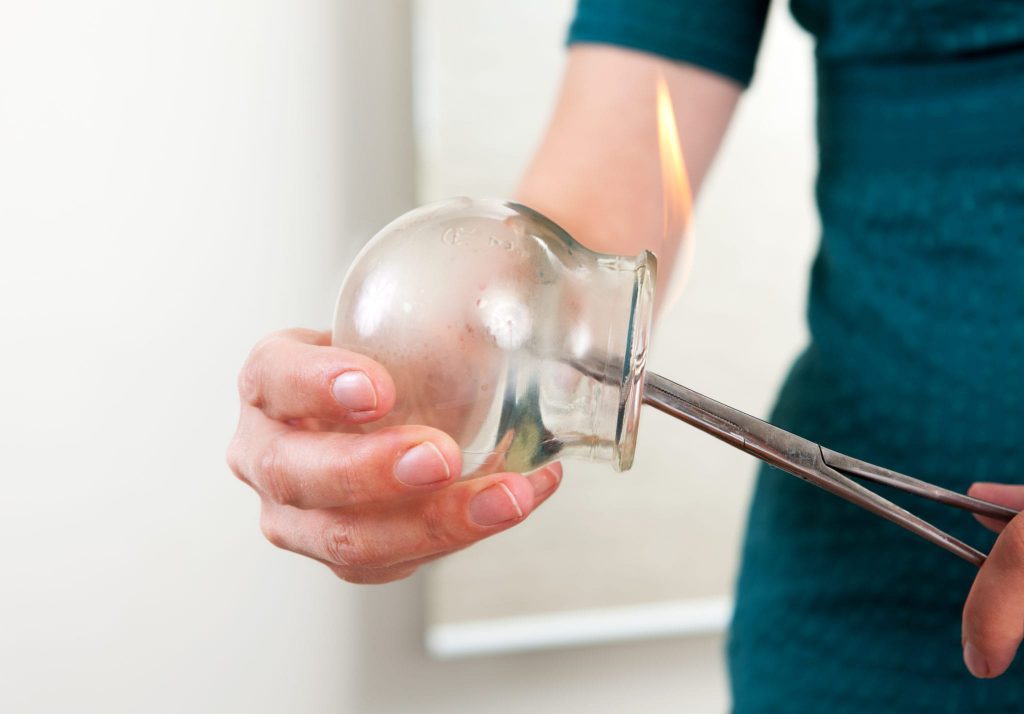CUPPING

Cupping is a simple suction technique that has been used by various cultures all over the world for thousands of years. Historians believe that cupping is the most ancient technique in Chinese medicine, predating acupuncture. Suction is applied to the skin using glass, rubber, plastic, or silicone cups (in ancient times animal horn or sections of bamboo were generally used). The vacuum action of cupping rapidly facilitates the release of rigid soft tissues, it loosens and lifts connective tissues, it breaks up and drains stagnation, and it increases blood and lymph flow to skin,muscles, and connective tissues. It does all of these things far more rapidly and effectively than any other type of therapy, including acupuncture, massage therapy, chiropractic adjustments, medications or even surgery.
Pain implies a blockage in the flow of energy and blood through a particular area. When injuries occur deep in the muscle, bleeding often results, which causes deep bruises and the accumulation of sticky proteins in the soft tissue. The combined presence of these elements causes stagnation and impaired micro-circulation in the area, resulting in pain, dysfunction, and stiffness that can persist for decades.This accumulation of cellular waste in the muscles or joints can be very difficult for the body to remove. The vacuum formed by cupping draws out old non-circulating stagnant blood and sticky fluids from painful areas, bringing these waste products to the skin level and away from the injury so that healthy free circulation can be restored to the affected area. This makes space for the oxygen, living cells, and nutrients that are needed for healing. At the skin level, the body’s capillary system can carry the toxins away to the liver and the kidneys, where they can be metabolized and excreted.
In areas where there is dead blood, lymph, cellular debis, pathogenic factors, and toxins present in the body, cupping will leave marks which indicate that the stagnation has been moved from the deeper tissue layers to the surface (see photo at right and links below for example photos of what these marks look like). The color and pattern of the marks depends on the level of stagnation in the area. Marks range from bright red to dark purple and usually last from three days to a week (sometimes longer if a person is very sick or sedentary). If there is no stagnation present (or if the cause of the pain is a nerve or bone problem), there will be only a light pink mark which disappears in a few minutes to a couple of hours. Sites where there is old trauma or injury may require multiple cupping treatments to remove all stagnation. Patients will find in follow up treatments the marks will be lighter and lighter as the pathogens are systemically removed from the body. Cupping marks are NOT bruises and they are generally not painful. Although the cupping treatment itself can be slightly uncomfortable and the marks can look dramatic, the presence of color in the cupped areas guarantees that the patient will feel immediate relief after the treatment.
Cupping is a powerful anti-aging technique. By the age of forty, approximately 60% of the body’s micro-circulation is no longer active. This contributes to age-related aches, pains, and fatigue. By powerfully drawing blood into the body’s smallest blood vessels, cupping helps to re-establish a more youthful micro-circulatory system. This results in muscles and joints that are more comfortable and are more resistant to injury.
It is important following cupping to keep the treated area covered and protected from drafts and extremes of temperature (hot tubs, cold swimming pools, etc). This is because cupping powerfully opens up the surface of the body. If the area is not kept warm and covered, cold and other pathogenic factors can invade and cause spasm, tightness, and stagnation to return. Please plan to have cupping therapy done at a time when you will be able to keep the treated area covered for at least three days following the treatment. The day before a formal event where you will be wearing a backless dress is NOT the time to have cupping therapy done! Drink plenty of water after your cupping treatment to assist your body’s efforts to clear toxins through its normal excretory channels. If your cupping marks are very dark or the area treated is very large, I may prescribe topical and/or oral herbal medicines to assist your body’s efforts to carry away the released toxins. It is fine to take over the counter pain relievers such as Tylenol or Advil to help with any lingering discomfort following a cupping session; such lingering discomfort is more common in patients with chronic conditions such as fibromyalgia.
In addition to its use for chronic pain, cupping is very effective for airborne allergies, cold and flu, chronic and acute bronchitis, and difficulties with breastfeeding.
Cupping has been used in many cultures for thousands of years. Cupping therapy was used in Egypt over 3,500 years ago, where its use is represented in hieroglyphic writing. In ancient Greece, Hippocrates recommended the use of cups for a variety of ailments, while in the early 1900’s British physician Sir Arthur Keith wrote about how he witnessed cupping performed with excellent success. Cupping was practiced by such famous physicians as Galen (131-200AD), Paracelsus (1493-1541), Ambroise Pare (1509-90), and surgeon Charles Kennedy (1826). In China, extensive research has been carried out on cupping and the practice is a mainstay in government-sponsored hospitals of Traditional Chinese medicine (TCM). During the Beijing Olympics, numerous news stories covered the use of cupping amongst elite athletes (see photo above and links below). The fundamental therapeutic value of cupping has been documented through several thousand years of clinical and subjective experience and has advanced its application to many areas.
Although cupping is a simple technique, it should only be done by an expert practitioner. Although some massage therapists, chiropractors, or estheticians offer cupping therapy, they generally lack the in-depth training and experience that is required to apply cupping therapy safely and effectively. At best, cupping therapy performed by an untrained practitioner will be ineffective. At worst, it can cause burns, blisters, or scar tissue that result in further pain as opposed to providing the relief you are seeking. I have the extensive training and experience, as well as specialized equipment, that is required to perform cupping safely and effectively. My background includes advanced training with Susan Johnson (www.tungspoints.com), the premier cupping therapist in the United States, as well as over a decade of experience in using this special technique.
Cupping therapy can be performed during your acupuncture appointment. The combination of these two therapies is dynamite — cupping can shave weeks off the treatment time that is required to heal many conditions. The cost of cupping therapy when it is done on the same day as acupuncture is $40.00. Cupping therapy alone is $60.00. Prior to cupping therapy, you will be asked to sign a special consent form indicating that you understand that the therapy will leave red or purple marks that may persist for up to two weeks after your session.
Cupping therapy in the news:
On Your Marks for an Ancient Therapy
Traditional Chinese Medicine Technique Uses Heated Glass Cups to Heal Ills
More information about cupping from my mentor Susan Johnson. Includes photos of cupping marks on days one through seven after treatment, as well as information about what to expect from cupping treatment:

